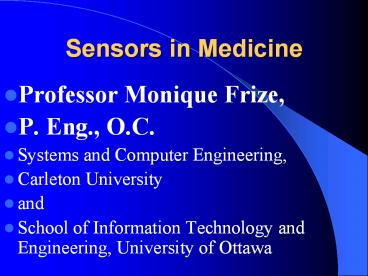Sensors%20in%20Medicine - PowerPoint PPT Presentation
Title:
Sensors%20in%20Medicine
Description:
Cardiology and cardiac surgery. Neurology and Neurosurgery. Dialysis and nephrology ... Ophtalmology, ENT (ear, nose and throat) Overview neonatal equipment ... – PowerPoint PPT presentation
Number of Views:137
Avg rating:3.0/5.0
Title: Sensors%20in%20Medicine
1
Sensors in Medicine
- Professor Monique Frize,
- P. Eng., O.C.
- Systems and Computer Engineering,
- Carleton University
- and
- School of Information Technology and Engineering,
University of Ottawa
2
Medical Instrumentation
- Diagnostic
- Therapy
- Monitoring
3
Patient type
- Emergency medicine
- Operating rooms
- Critical care units
- Obstetrics
- Pediatrics
- Adults
- Palliative care
4
Medical Specialties
- Medical Imaging
- Laboratory and pathology
- Cardiology and cardiac surgery
- Neurology and Neurosurgery
- Dialysis and nephrology
- Urology
- Gastro-enterology
- Ophtalmology, ENT (ear, nose and throat)
5
Overview neonatal equipment
- http//www.neonatalogy.org/tour/equipment.html
6
(No Transcript)
7
(No Transcript)
8
Example Bring a premature, sick baby to CHEO
from Iqualuit
- NEEDS
- The baby stays at CHEO until stabilized and well
- The baby has cardiac and respiration problems,
losing heat quickly - Ensure the proper monitoring and care for the
infant - The parents arent able to stay for the full five
months in Ottawa, therefore find a way to keep
parents updated and informed
9
First Step
- Contact CHEO via phone from the hospital in
Iqualuit and notify them about the arrival of the
baby and its current status - Maintain communication during the trip using
radio contact
10
Procedure, continued...
- Use a helicopter for the flight
- During the flight there will be a travel
incubator to keep the baby warm - An apnea monitor will check the babys breathing
- An ECG monitor will display the babys heart rate
- There will be a paramedic to watch over the baby,
as well as the babys parents - A ventilator may be needed and a pulse oximeter
11
(No Transcript)
12
(No Transcript)
13
(No Transcript)
14
(No Transcript)
15
Next Steps at CHEO
- The baby will be transferred to a stationary
incubator in the neonatal intensive care at CHEO,
will have the apnea monitor, the cardiac
monitor, and ventilator if respiratory problems,
oximeter - The infant is attended on a 24 hour basis by
nurses and physicians (neonatalogists) - There are automatic alarms to notify of problems
- The babys parents will be close to their baby
for a few nights
16
After the parents leave...
- The parents will stay in touch with the hospital,
by using the internet and the phone - There will be a video monitor so the family will
be able to see their baby - The parents will be updated about their babys
progress - The internet web site will be secure, along with
a password protected access that only parents and
the assigned physicians and nurses can access
17
Keeping in touch
- Bi-Weekly Updates on telephone with doctors.
- Web-cam tapes child 24/7, and is broadcasted to
the family over the internet, using a password
protected site, that only the family and hospital
are able to access and update, constantly. - And frequent emails updating the family on
infants specific condition - Talk to baby/sing to baby through internet
technology or telephone
18
(No Transcript)































